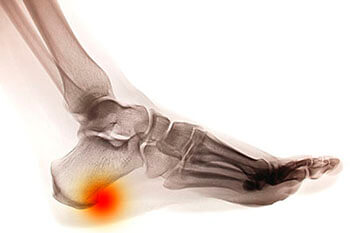Heel Spurs Treatment in Concord, NC
 Heel spurs are brought upon by a calcium deposit that causes a bony protrusion on the underside of the heel bone. It normally forms over time and can best be diagnosed through an x-ray examination. Heel spurs are commonly linked with plantar fasciitis, an inflammation that runs along the bottom of the foot. Common symptoms of heel spurs include pain towards the affected area, inflammation, and swelling at the front of the heel.
Heel spurs are brought upon by a calcium deposit that causes a bony protrusion on the underside of the heel bone. It normally forms over time and can best be diagnosed through an x-ray examination. Heel spurs are commonly linked with plantar fasciitis, an inflammation that runs along the bottom of the foot. Common symptoms of heel spurs include pain towards the affected area, inflammation, and swelling at the front of the heel.
Heel spurs are more common than people expect them to be. They are most common in people age forty and over, although heel spurs can occur in people younger than forty, and frequently affect athletes or people who are very physically active. Heel spurs are also common in those with poor circulation and degenerative diseases. People who suffer from arthritis may suffer from heel spurs as well.
Some risk factors for developing heel spurs include running and jogging on hard surfaces, being obese, wearing poorly fitting shoes, or having walking gait abnormalities.
There are different causes that may lead to a heel spur including poorly fitted shoes, excess weight or obesity, repetitive stress from running or jogging on hard surfaces, and arthritis. Treating a heel spur often requires a lifestyle change as well as getting plenty of rest. Using cold compresses is another method to help alleviate the discomfort of a heel spur. To prevent further damage, it may be useful to look into wearing shoe inserts or custom orthotics.
Heel spurs can be prevented by wearing well-fitting shoes that have shock-absorbent soles. You should also be sure that you are choosing the right shoe for the activity you want to partake in; for example, do not wear walking shoes when you want to go on a run. Additionally, maintaining a healthy weight can be beneficial toward preventing heel spurs, as it will prevent an excess amount of pressure being placed on the ligaments.
There are less conventional ways that are becoming more popular ways to treat heel spurs. One option would be to use a night splint which reduces the pain caused from heel spurs if worn overnight. Other alternative treatment methods that can be used are ultrasound, or acupressure. There are also other tolls that can be used are heel cups, heel seats, heel pads, arch supports, and insoles.
Self-Care for Heel Spurs
Practicing different exercises can help reduce the pain of heel spurs as well decrease inflammation you may be experiencing. Some of these helpful exercises include calf stretches performed either against a wall or on steps, foot rolls with a golf or tennis ball, seated foot flexes, and towel grabs with your toes. Heel spur prevention can start by understanding the everyday stresses put on your feet and knowing when to let your feet rest. It’s also important to not let heel pain go uncared for. Once you notice something is off, take action instead of waiting to see if it goes away.
If you’d like more information about heel spurs, consult with a podiatrist who can provide you with a proper diagnosis and professional care.
